#xi'an square
Text

Sheng Qi (Chinese, 1965), Xi'an Square D, 2009. Acrylic on canvas, 100 x 80 cm.
1K notes
·
View notes
Text





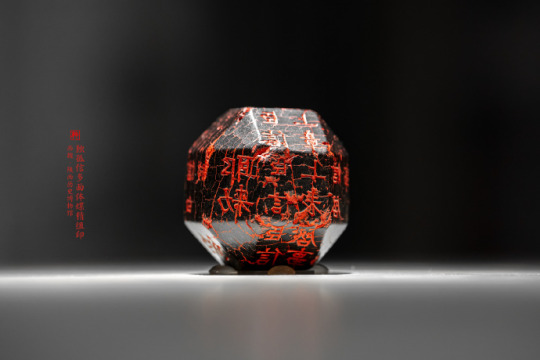
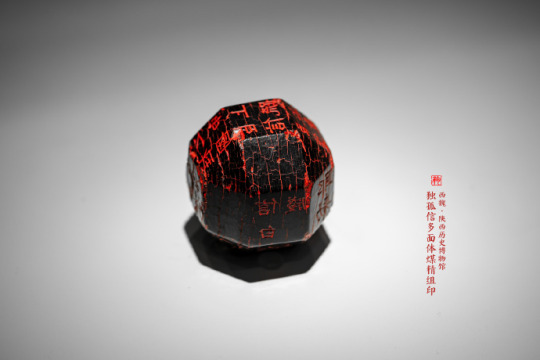

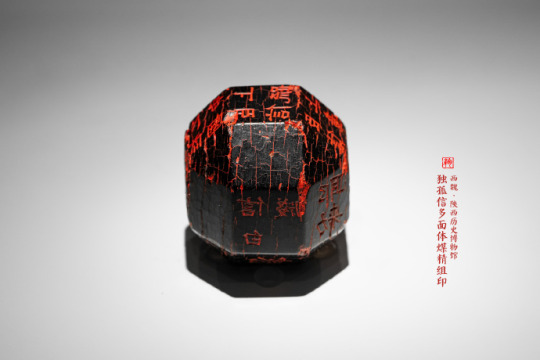
Jet-black Polyhedral Seal of The Western Wei General
This multi-faceted jet seal of the Western Wei dynasty, belonged to the famous General Dugu Xin (獨孤信). It has 8 edges and 26 sides: 18 square and 8 triangular ones. It is the ancient polyhedral seal with the largest number of facets.
Among them, 14 sides are engraved with inscriptions. The inscriptions range from one-character to five-character. The functionality is differentiated, including the use in official letters, orders, document labeling, etc.
The jet, a composite organic gem, from which the seal is carved, is known in China as “coal jade” (煤玉).
The total height of the object is 4.5 cm, the width is 4.35 cm, and the weight is 75.7 g.
The seal was accidentally discovered in 1981 by Song Qing, a student from Xunyang county (旬陽縣), Ankang, Shaanxi. While returning home from school, he picked up a weird object in the gravel on the roadside, which aroused his curiosity with its bizarre shape. Song Qing had no idea what it was. Having examined the inscriptions at home, he gave the find for examination to the local archaeological museum, where the artifact was considered not of particular cultural value.
The seal vegetated on the outskirts of the local exposition for another decade, until it was revealed and recognized by a prominent researcher Wang Hanzhang (王翰章) from the Xi'an Institute of Literature and History. On display in Shaanxi History Museum (陝西曆史博物館).
#ancient china#chinese culture#chinese history#chinese seals#seal#seals#calligraphy#lettering#chinese calligraphy#jet#carving#stone carving#gemstone#gems#gemstones#lignite#jet-black#Western Wei dynasty
275 notes
·
View notes
Text


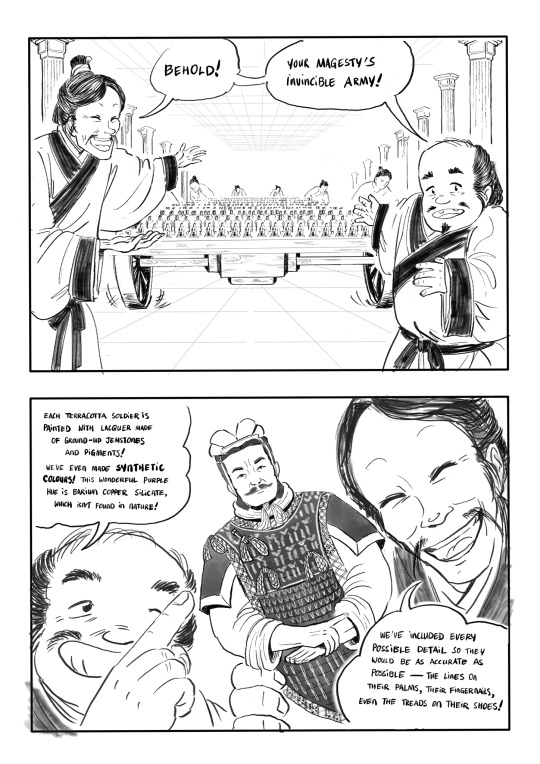
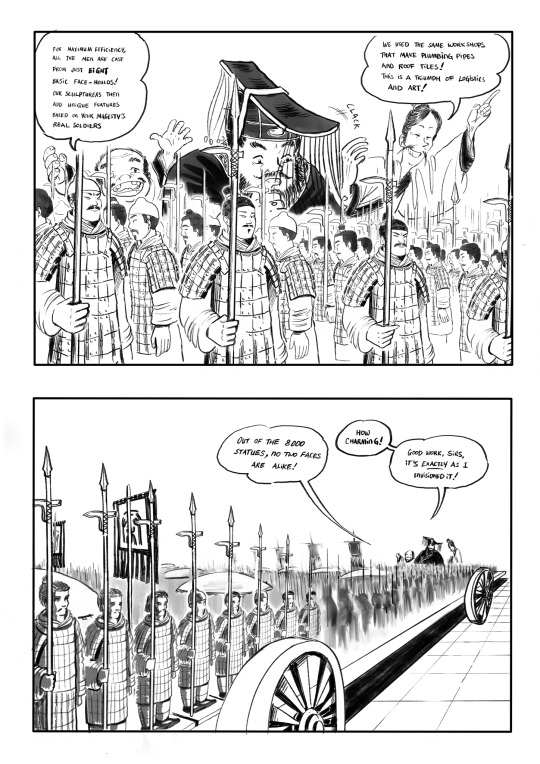

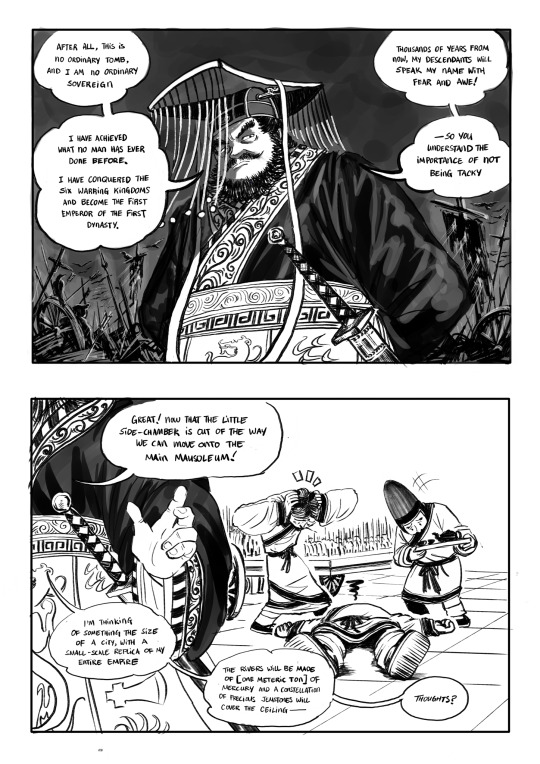
—Terracotta—
Ok so I visited xi'an during my trip back to china (3 months ago?), and this idea popped into my head during the 9h train ride back to shangdong. I am of course 100% projecting my own love of the terracotta army onto Qin Shi Huang, in reality he did not care for this pit of mud statues depicting lowly commoners. In fact, no one ever bothered to write about it and they were lost to history until 1974 when some farmers digging a well stumbled upon them. But it's exactly the reason I'm so fascinated by them. QSH's tomb has not been excavated, and although I have a running joke about cracking it open--mercury vapors be damned--none of the riches inside will ever enchant me as much as the chance to see the face of a person who lived during this time.
Notes under the cut:
#1
the title Qin Shi Huangdi means "First Emperor of Qin" and was given to QSH by later historians. He actually called himself the Shi Huangdi, "First Emperor", and that is the title I've gone with here.
in English the other kingdoms are translated as "states" (i guess to avoid confusion?) but in chinese they are very much kingdoms.
The terracotta warriors used thousands of craftsmen, many of whom were slaves from conquered kingdoms. From a storytelling perspective I thought it would be more streamlined if there were two main artisans who reported directly to QSH.
QSH's clothes are based on the overly complicated courtly regalia. which has 12 symbols that only the emperor is allowed to wear
Notice how this hat is ROUND at the front??? Well I CERTAINLY DIDN'T. HAD TO REDRAW IT!!!!!
the stripped shirt is based on this Chu woman figurine. Clothes were fairly unisex during this time and I thought it was a nice fit.
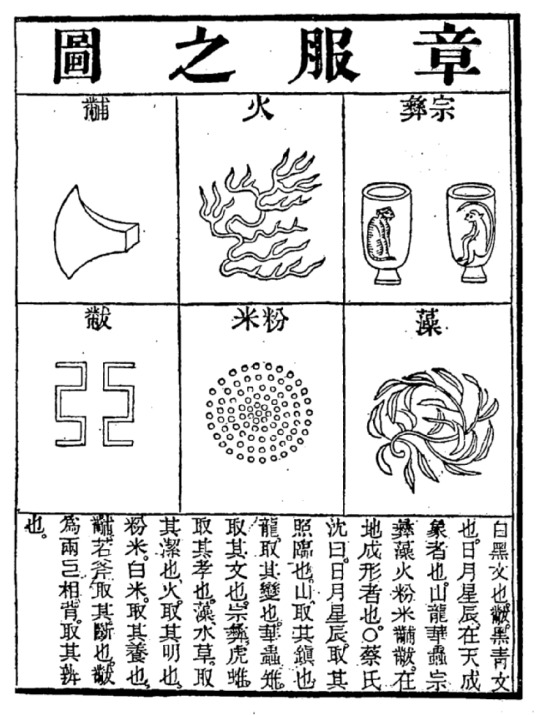
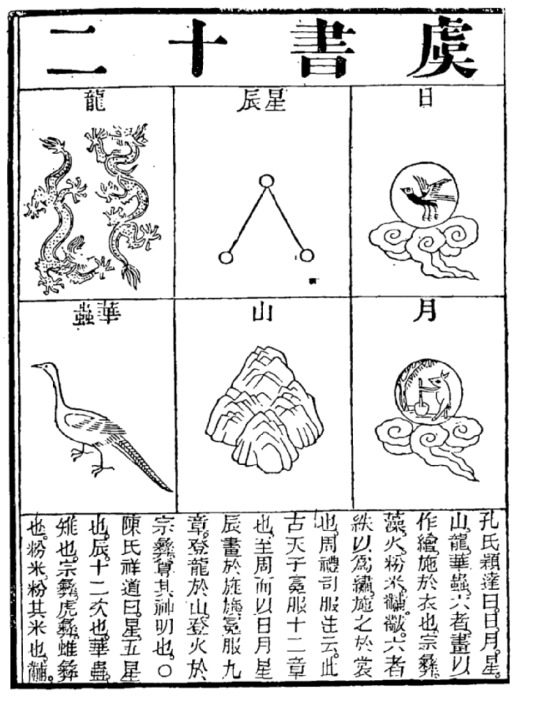



#2
Paperwork: writing was done on books made of bamboo slips. Anecdotally, QSH had an impressive work ethic and would read 100 bills every night.
Bronze Goose lamp: ok this is actually a Han dynasty lamp pls forgive me. I saw this bad boy at the xi'an history museum and it's bewitched me body and soul. The goose neck is hollow and connects to a reservoir of water in the belly, which minimizes smoke and cools the lamp.
QSH is remembered as a brutal tyrant and brilliant statesman, but I wanted to present a more human version of him here. Bored, tired and drowning in work he refuses to delegate. His new empire is balanced as precariously as everything else on his desk.
#3
The attendants standing behind him are holding little wood tablets called hu for taking notes. Their brushes are tucked into their hats/hair, inspired by Han dynasty custom. (You'll see me using Han stuff a lot. Their cultures were very similar to Qin, since it was only a few hundred years apart).
So I had a slight breakdown trying to find the correct hats for the eunuchs, and ended up redrawing everything the night I was due to publish. Closest thing I could come up with was a reference to a round-style Han Dynasty hat which evolved into this square Jin hat. Yes, this is a cry for help .
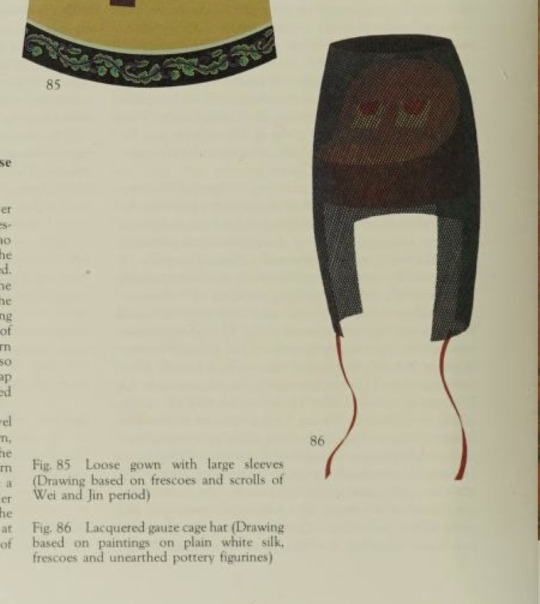
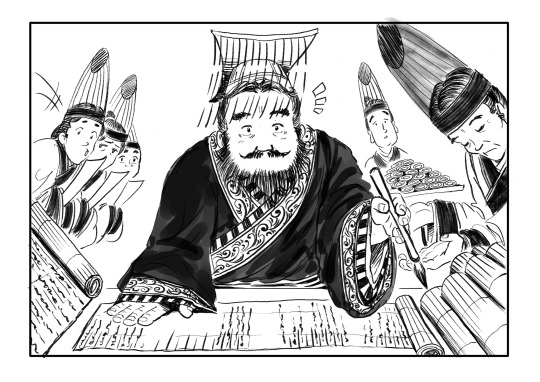
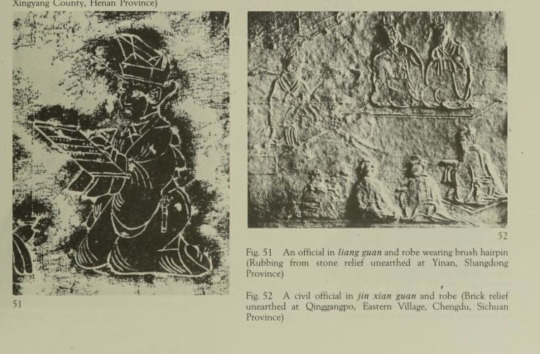
#4
the wheeled platform is 100% made up, I tried to come up with a plausible way of getting a bunch of figurines into the palace.
#5 & #6
Painted terracotta soldier
How were the terracotta warriors made
The General: Fun fact, I got to see this guy in person!
#7
The Epic Wide Shot was inspired by some Tang Dynasty terracotta figures I saw at the xi'an museum!
#8
THIS KNEELING ARCHER. ARGGGGG. He use to be my favourite guy. I even went into the pit and drew him IN PERSON. the archers inexplicably have their hair buns on the OPPOSITE SIDE OF THE HEAD. So because of him, I DREW ALL THE HAIR BUNS WRONG!!!! REDRAW!!!! PAIN AND SUFFERING!!!!

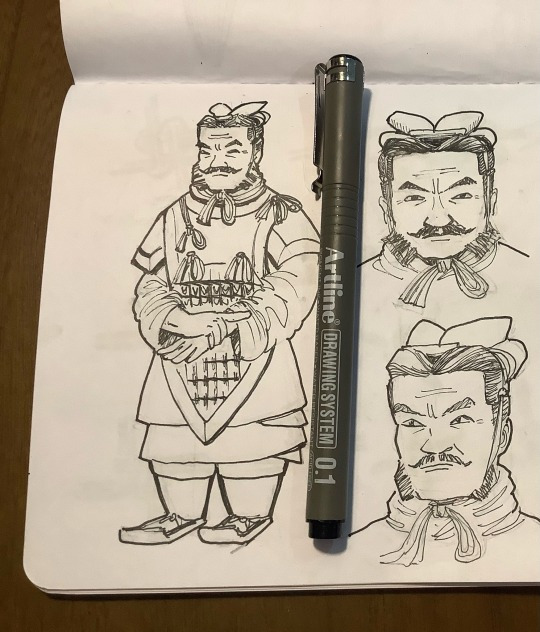
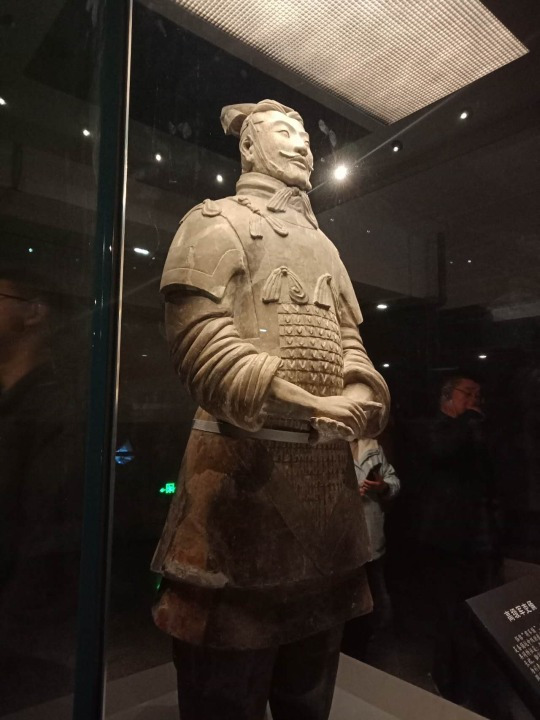
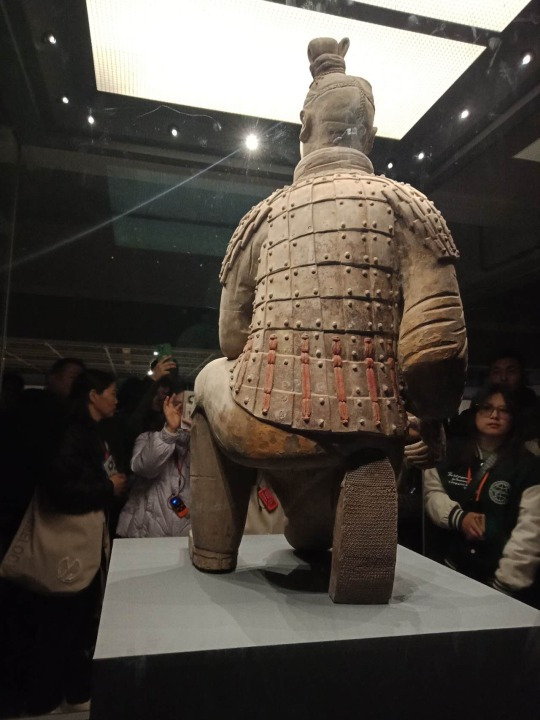


#10
Qin was famous for it's very long, thin swords. They were more useful as status symbols than actual weapons, as QSH knows from personal experience…
#11
QSH'S Tomb hasn't been excavated yet, but high levels of mercury have been detected in the soil, making the historical accounts of quite plausible.
#chinese history#warring states period#qin dynasty#qin shi huang#terracotta army#comics#my art comes with homework lol#art
201 notes
·
View notes
Text
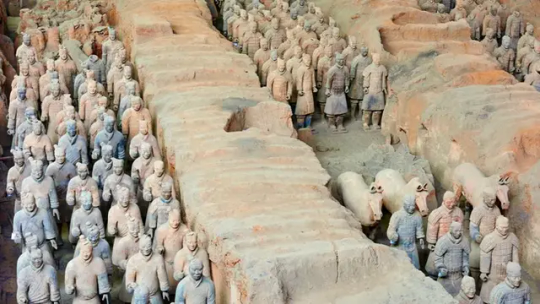

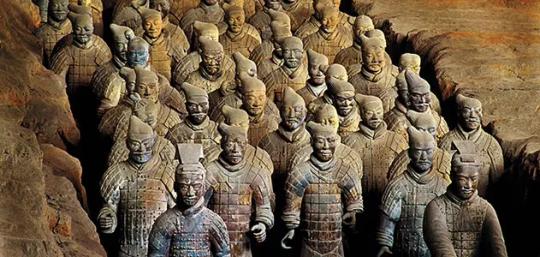
A Rare 2,000-Year-Old Sheep-Drawn Chariot Discovered Near China’s First Emperor
Only the sheep's skeletons remain, but such vehicles appear in Chinese lore.
Archaeologists have discovered the remains of what appears to be an ancient sheep-drawn chariot near the famous "Terracotta Army" in northwestern China.
The English-language website China Daily, which is owned by the Chinese Communist Party, reported that the remains were found in the "western tomb" at the site of Emperor Qin Shi Huang's mausoleum, a few miles northeast of the city of Xi'an in Shaanxi province.
Archaeologist Jiang Wenxiao, who is leading the excavations of the tomb, told China Daily that the main structure of the chariot had rotted away after spending more than 2,000 years in the ground. (The mausoleum dates to the third century B.C.)
But the team did find a row of six sheep skeletons wearing accessories used for pulling a chariot, so they inferred this was a sheep-drawn chariot, Wenxiao said.
Drawn by sheep

Horse-drawn chariots and ox-drawn carts were common in ancient China, but a sheep-drawn chariot is an extremely rare find, Wenxiao said.
They appear in Chinese history, however, as well as in Chinese lore. The founder of the Western Jin dynasty, Emperor Wu (or Sima Yan), who ruled from A.D. 266 to 290, is said to have ridden in a sheep-drawn carriage around his palace complex every night and would sleep wherever the sheep stopped.
His practice may be the origin of the modern Chinese phrase "seeking luck in a sheep cart"; it's said the emperor had a harem of 10,000 wives, and this seems to have been Sima Yan's method of choosing among them.
Wenxiao presented the discoveries at the Fourth Congress of Chinese Archaeology, which was held in Xi'an in October, according to the state-owned website ECNS.cn.
The team hopes laboratory analysis on the western tomb's burial chamber, which is currently underway, will help them determine who was buried there, the report said.
Chinese chariots
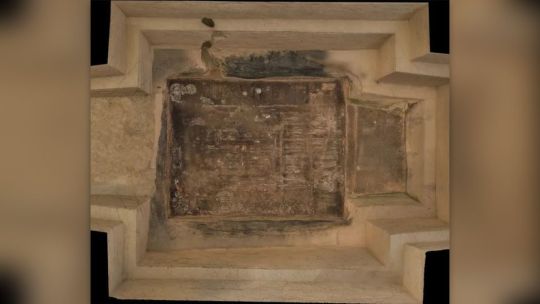
In addition to the six-sheep chariot, archaeologists unearthed a four-wheeled wooden chariot, presumably drawn by horses, equipped with an ornate rectangular umbrella. It is the oldest of its type ever found, according to Wenxiao.
They also found a wealth of copper chariot and horse-related artifacts, as well as iron tools and copper weapons, providing new insight into the period when iron tools first began to appear.
The mausoleum of Emperor Qin Shi Huang, who ruled from 221 to 210 B.C. and is considered the first emperor of a united China, is spread over about 10 square miles (26 square kilometers) and took 38 years to complete. Three immense pits in the mausoleum site hold more than 8,000 life-sized sculptures that depict the emperor's soldiers and their horses — the so-called Terracotta Army.
By Tom Metcalfe.
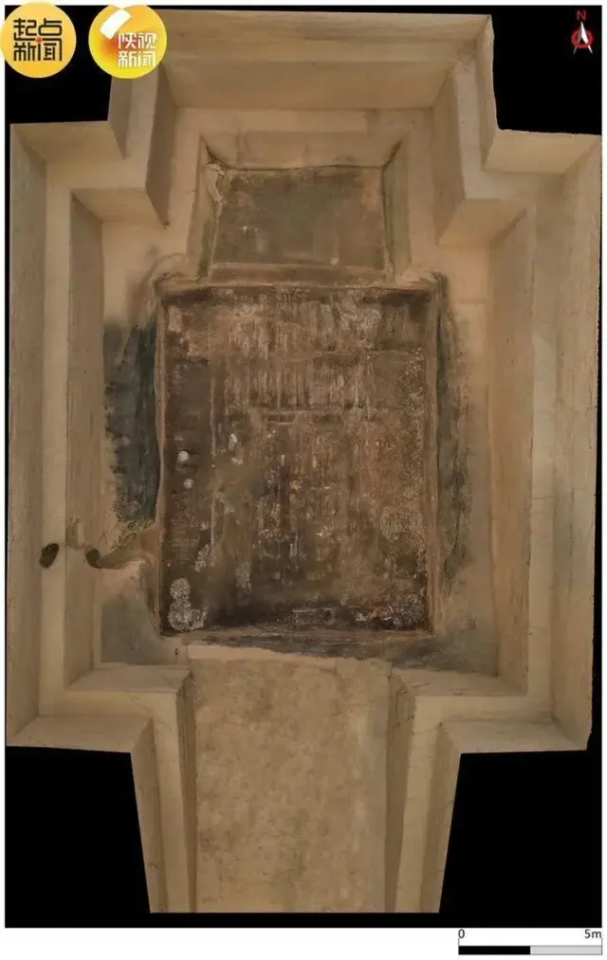

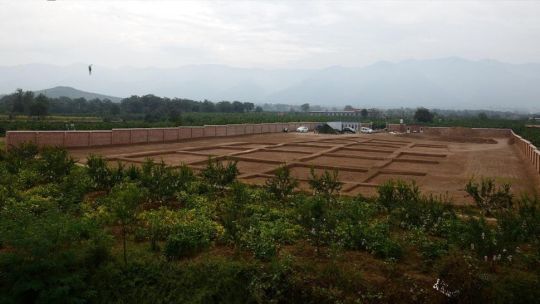
#A Rare 2000-Year-Old Sheep-Drawn Chariot Discovered Near China’s First Emperor#Terracotta Army#Emperor Qin Shi Huang#Qin dynasty#Xi'an Ciina#Shaanxi province#chariot#ancient tomb#ancient grave#ancient artifacts#archeology#archeolgst#history#history news#ancient history#ancient culture#ancient civilizations#ancient china#chinese history
46 notes
·
View notes
Photo

The Yu Ji Tu, or "Map of the Tracks of Yu", carved into stone in 1137, located in the Stele Forest of Xi'an. This 3 ft squared map features a graduated scale of 100 li for each rectangular grid. China's coastline and river systems are clearly defined and pinpointed on the map.
83 notes
·
View notes
Text
🎂 SEHUN BIRTHDAY – Oh Sehun Bar's Project 𝐖𝐚𝐥𝐤 𝐢𝐧 𝐭𝐡𝐞 𝐰𝐢𝐧𝐝·沐风而行
𝙋𝘼𝙍𝙏 1. A new start: smart classroom
In the name of Sehun & Xunqi, oshbar donated and built a smart classroom for rural schools in remote areas of Guizhou, using nano smart blackboards, advanced teaching technology, tutorials and smart learning packages.


𝙋𝘼𝙍𝙏 2. A new start: To bravery
It is very difficult for poor patients with serious diseases to seek medical treatment, and they suffer from both mental and financial pressure. Help from society is the hope of life for them. This project is aimed at children aged 0-16 years old with serious diseases (leukemia, cancer, tumors, rare diseases and other serious diseases), and helps them raise drug expenses and living subsidies.


𝙋𝘼𝙍𝙏 3. A Trip to Wonderland: Sehun themed pavilion in GuangZhou, China


𝙋𝘼𝙍𝙏 4. Distribution of birthday merch sets to all oshbar branches from 22 cities in China.



𝙋𝘼𝙍𝙏 5. Incheon Airport AMT Ads
📆 April 1-30




𝙋𝘼𝙍𝙏 6. Mystery of the Day: COEX S-Live Ad
Sehun will be the first male K-pop idol to be featured on this project. S-LIVE in the corridor consists of a large screen in the middle and 14 small screens on the left and right sides, with a total screen area of nearly 120,000 square meters.
April 8-14
Frequency: 70 times/day
Duration: 30 seconds
Time: 7:00-23:00



𝙋𝘼𝙍𝙏 7. Prelude to the tide: COEX Brand Avenue
April 8-14
Frequency: more than 150 times/day
Duration: 30 seconds
Time: 06:00-24:00



𝙋𝘼𝙍𝙏 8. Waiting and Dawn: 🇨🇳Changsha Pozi Street LED Screen Ad
April 12-13
Time: 10:00-23:00

𝙋𝘼𝙍𝙏 9. Sunset kiss——Beijing SOLANA 3D Screen🇨🇳
The screen is located in the northwest corner of Chaoyang Park
April 12-13
Time: 10:00-22:00
Duration: 15s
Frequency: 60 times/day

𝙋𝘼𝙍𝙏 10. Wind of freedom: 🇨🇳Xi'an Shopping Mall (Joy City) Sky Curtain LED Screen + Outdoor Large Screen
April 12-13
Frequency: 120 times/day
Duration: 15s
Time: 10:00-22:00


𝙋𝘼𝙍𝙏 11. Becoming time: 🇨🇳Shenzhen Longgang Wanda Shopping Mall
Sehun will the first K-pop male idol to be featured on this project🔥
April 12-14

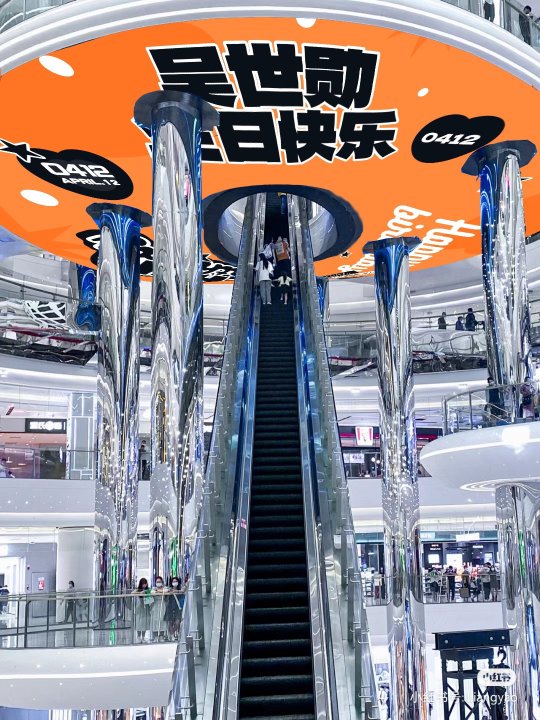
#exo sehun#sehun exo#oh sehun#sehun oh#exo#sehun#sehun birthday#happy birthday sehun#happy sehun day#sehunnie#exol#exo-l#세훈#엑소#xunqi#오세훈#엑소세훈
3 notes
·
View notes
Photo

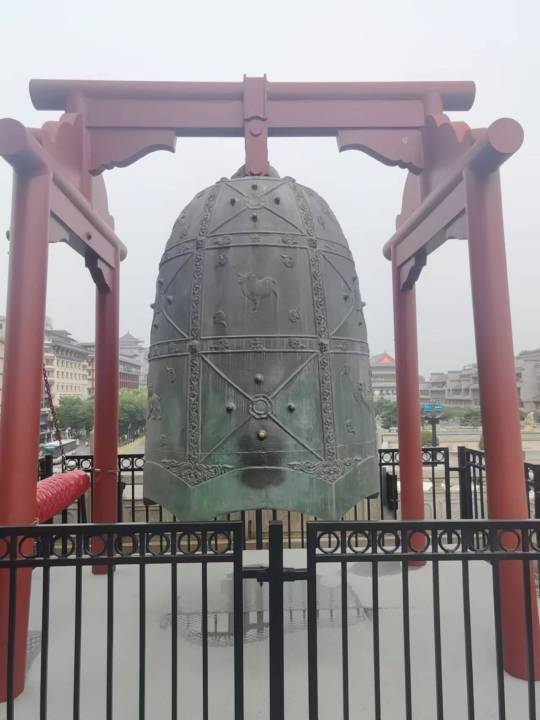




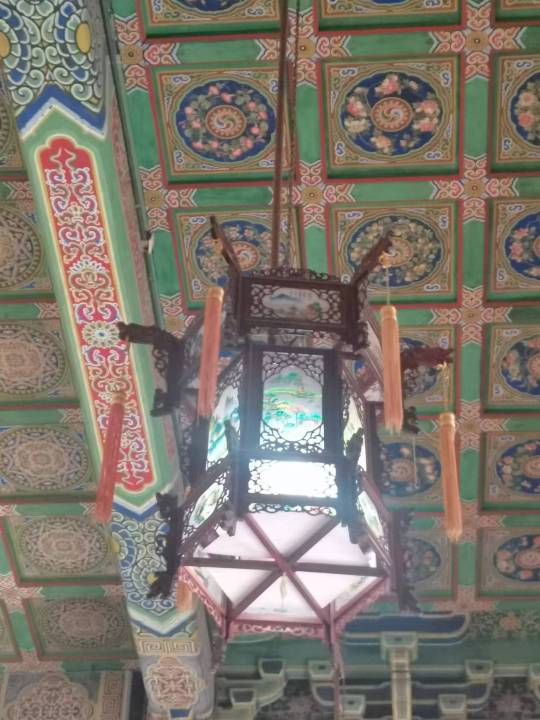

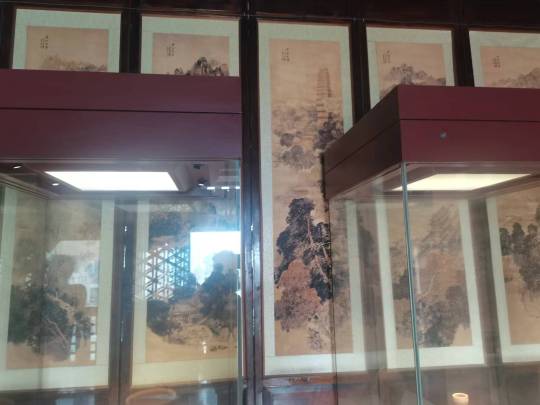
Today (7.15.2022)’s visit to the Xi’an Bell Tower by me. Was a real treat this morning!
Per Wikipedia:
The Bell Tower of Xi'an (simplified Chinese: 西安钟楼; traditional Chinese: 西安鐘樓; pinyin: Xī'ān Zhōnglóu), built in 1384 during the early Ming Dynasty, is a symbol of the city of Xi'an and one of the grandest of its kind in China. The Bell Tower also contains several large bronze-cast bells from the Tang Dynasty. The tower base is square and it covers an area of 1,377 m2 (14,820 sq ft). The tower is a brick and timber structure and close to 40 m (130 ft) high. It is located in the center of Xi'an, at the intersection of the four streets of the east, west, south and north. It is the largest and most preserved one amongst the many bell towers left over from ancient China.
#china#xi'an#chinese history#chinese architecture#ming dynasty#chinese culture#shaanxi#tang dynasty#history
2 notes
·
View notes
Text
Top 5 ancient sites in China to visit
Take a trip back in time as we explore China's ancient sites, which hide a rich cultural legacy and history dating back thousands of years. China is home to several historical monuments that continue to enthral tourists from all over the world, including the magnificent Great Wall and the mysterious Terracotta Army. Get ready to go back in time to dynasties long since passed and civilizations that have left a lasting impression on the rich historical fabric of China as you explore its varied landscapes. China's historic landmarks provide a window into the nation's colourful history, whether you're drawn to the elaborate carvings of ancient tombs or the soaring pagodas of Buddhist temples. Come along on an exploratory voyage with us as we solve the secrets surrounding China's historical treasures, each place serving as a testament to the creativity, inventiveness, and tenacity of its founders. China's historical attractions, which range from the imperial magnificence of the Forbidden City to the tranquil serenity of the Longmen Grottoes, are guaranteed to astonish and amaze in equal measure. Gather your belongings and get ready for an unparalleled journey as we set off to see China's historical monuments. China's historical riches are waiting to be discovered, whether you're a history buff, a cultural seeker, or just interested in learning about the glories of the past.
Here are some ancient sites in China to visit.
1. China's Great Wall: The "Great Wall of China," which is located an hour outside of Beijing, is one of the most well-liked, breathtaking, and well-known tourist attractions in China. One of the seven wonders of the world, the wall is the longest wall in the whole globe. This wall is around 5,000 km (3,100 mi) long, extending from China's western border to its eastern shore. Near Beijing are the portions that have been integrated, renovated, and preserved the most. An iconic representation of China's historical and architectural resistance against the "Mongol Invasions" is the wall. During the summer, "Mutianyu," one of the Great Wall's sections, sees the highest number of visitors. The Gorges area is passed by an exciting and terrifying cable car journey that is available to guests.
2. The City of Forbidden: This iconic location is called the "Forbidden City—Imperial Palace" and is located in Beijing. The common people were not allowed to enter this city or palace, which was constructed for the use of the Chinese emperors. China's "forbidden city" is a lavish and breathtaking display of the country's traditional architectural style. The roofs of almost 8,000 of the apartments are golden. The exquisite patterns of the rooms are painted in shades of red and yellow. This location was a Ming and Qing Dynasty palace that was home to 24 emperors. One of the world's five most significant palaces, Forbidden City accurately captures the history and culture of China.
3.Heaven's Temple: Situated in the southeast of downtown Beijing lies the Temple of Heaven. The reason this location is called the Temple of Heaven is that it is a collection of religious structures where the Heaven Worship Ceremony was performed throughout the Ming and Qing dynasties. The total size of the temple is around 2,700,000 square meters. This temple's architect and design have been conserved to provide insight into the religious customs of the pre-Columbian Chinese cultures. A lengthy wall encloses the two distinct structures that make up the Temple of Heaven. The round northern section of the temple is enclosed by the wall, which represents heaven. In contrast, the southern portion of the temple is a square, which represents the earth. Furthermore, two surrounding walls split the temple into its inner and exterior halves.
4. The City Wall of Xi'an: When someone enters Xi'an, the "City Wall of Xi'an" is one of the most notable sites they will see. The Ming Dynasty Emperor constructed this wall to protect the city. One of the oldest and biggest city walls in use for military defense is the one at Xi'an. Emperor Zhu Yuanzhang stretched the wall further. The current height of Xi'an's city wall is 40 feet (12 meters), its width is 40 to 46 feet (12–14 meters), and its thickness at the bottom is 50 to 60 feet (15–18 meters). The wall is approximately 8.5 miles (13.7 kilometers) long, with 98 ramparts spaced every 120 meters. To keep adversaries away from the wall, the troops stationed at the Ramparts have sentry houses. The four gates of the City Wall are called "Yongning Eternal Peace" in the south, "Anding Harmony and Peace" in the west, "Changle Eternal Joy" in the east, and "Anyuan Forever Harmony" in the north. One of the gates with the most exquisite decorations is the Yongning gate.
5.Summer Palace: Beijing is home to the Summer Palace, a masterwork of Chinese landscape architecture. The Summer Palace is a collection of breathtakingly designed buildings, gardens, and lakes. This location was constructed in 1750, destroyed during the war in 1860, and rebuilt according to the original plans in 1886. It has an exquisitely blended natural topography of hills and open water with man-made structures including pavilions, halls, temples, palaces, and bridges. The summer palace's well-planned gardens, which showcase the artwork and culture of past Chinese civilizations, are its most notable feature.
Conclusion
China's ancient sites offer a captivating journey through history, culture, and heritage. From the iconic Great Wall to the enigmatic Terracotta Army, these treasures stand as testaments to China's rich and storied past. For those eager to explore these ancient marvels, China tour packages offer convenient and hassle-free options to experience the best of the country's historical sites. With expert guides and well-planned itineraries, travelers can immerse themselves in the wonders of China's ancient civilizations. As you bid farewell to these timeless landmarks and the echoes of centuries past, you carry with you memories of awe-inspiring sights and profound insights into China's enduring legacy. Whether it's your first visit or a return trip, China's ancient sites leave an indelible mark on all who have the privilege to explore them. Pack your bags, secure your China tour, and embark on a journey of discovery through the ancient sites of China. From the grandeur of imperial palaces to the serenity of sacred mountains, China's ancient treasures await your exploration, offering a glimpse into the rich tapestry of the country's history and culture.
0 notes
Text
youtube
China is a vast and diverse country with a rich history, diverse landscapes, and a vibrant culture. From ancient historical sites to modern cities, there's a wide range of experiences to explore. Here's a guide to help you plan a visit to China:
1. Beijing:
The Great Wall of China: Explore this iconic symbol of China's ancient civilization.
Forbidden City (Palace Museum): Discover the imperial history of China in this massive palace complex.
Tiananmen Square: Visit the world's largest public square with historical and political significance.
Summer Palace: A beautiful imperial garden with a vast lake and historical buildings.
2. Xi'an:
Terracotta Army: Marvel at the thousands of life-sized clay soldiers, horses, and chariots.
Xi'an City Wall: Walk or bike along this ancient city wall that encircles the old city.
3. Shanghai:
The Bund: Stroll along this historic waterfront area with a mix of architectural styles.
Yu Garden: Explore a classical Chinese garden in the heart of Shanghai.
Oriental Pearl Tower: Enjoy panoramic views of the city from this iconic tower.
4. Guilin and Yangshuo:
Li River Cruise: Take a boat trip through the stunning karst landscapes.
Elephant Trunk Hill: Visit the iconic hill resembling an elephant drinking from the river.
5. Chengdu:
Chengdu Research Base of Giant Panda Breeding: See adorable pandas in a natural environment.
Jinli Ancient Street: Explore this historic street with traditional architecture.
6. Zhangjiajie:
Zhangjiajie National Forest Park: Known for its towering sandstone pillars and the inspiration for the floating mountains in "Avatar."
7. Hangzhou:
West Lake: Enjoy the scenic beauty of this UNESCO World Heritage site.
Tea Plantations: Visit Longjing (Dragon Well) tea plantations for a traditional tea experience.
8. Lhasa, Tibet:
Potala Palace: A UNESCO World Heritage Site, once the winter palace of the Dalai Lama.
Jokhang Temple: A sacred Buddhist site in the heart of Lhasa.
9. Harbin:
Harbin Ice Festival: Experience the stunning ice sculptures and winter festivities.
10. Dunhuang:
Mogao Caves: Explore the ancient Buddhist cave art and sculptures.
11. Hiking in Huangshan (Yellow Mountains):
Witness breathtaking scenery, ancient pine trees, and granite peaks.
12. Traditional Chinese Opera:
Attend a performance of traditional Chinese opera for a cultural experience.
13. Local Cuisine:
Try regional specialties like Peking duck, dim sum, hotpot, and various noodle dishes.
14. Language:
Mandarin is the official language. Learning a few basic phrases can enhance your experience.
15. Transportation:
China has a well-developed transportation system. Consider using high-speed trains for efficient travel between cities.
Remember to check for any travel advisories, entry requirements, and local regulations before planning your trip to China. Given the country's vastness, diverse cultural heritage, and natural wonders, tailor your itinerary based on your interests and the specific regions you plan to explore. Enjoy your journey through China!
#china#VisitChina#ChinaTravel#ExploreChina#Chinadventures#ChinaCulture#ChinaBeauty#ChinaLandscapes#ChinaHistory#ChinaHighlights#ChinaWanderlust#ChinaCityscape#ChinaTourism#ChinaPhotography#ChinaLove#ChinaDreams#ChinaSights#ChinaVibes#ChinaMemories#ChinaUnforgettable#ChinaEpic#chinacountry#Youtube
0 notes
Text
The 100 must-visit sceneries in China
Grand Tang Dynasty Ever-bright City 大唐不夜城
Grand Tang Dynasty Ever-bright City is located between the Giant Wild Goose Pagoda and Tang Paradise. The total construction area is 650000 square meters, making it the only large-scale pedestrian street in China with Tang Dynasty culture as the background.
#XianprivateTour#XianTravel#XianTrip#ShaanxiTour#ShaanxiTravel#xian#ChinaTour#China Travel Trip#chinamemorytrip#imemorytrip
0 notes
Text
Terra Cotta Warriors
Earthenware Champions it is an extraordinary disclosure in mankind's set of experiences and one of the eight miracles on the planet. The site is exceptionally positioned only close to the Pyramids in Egypt and the antiquated models in Greece, they are important fortunes.
ALSO VISIT:-Memorable Travel Experiences in China
The disclosure of the Earthenware Fighters was in Xi'an in 1974 by a neighborhood occupant. It set off the interest of Chinese archeologists who uncovered the 7,000 earth-made fighter and pony figures starting from the earliest stage. The most intriguing thing is that their face appearances and the "haircuts" of these fighter figures are not quite the same as one another. It required around 38 years with numerous skilled workers to finish this authentic undertaking.
In 221 BC, Sovereign Qin Shi Huang of the Qin Tradition laid out the principal unified line in China. After his passing, his kin covered him at the north of Lishan Slope in Lintong Region. The burial place is a slammed soil hill with a level of 47m. In 1974, three huge pits of earthenware figures were found around 1.5km east of the sepulcher. Among those three, the biggest one is Pit No.1, covering just about 14,260 square meters. The pit is separated into eleven passageways showing 38 sections of dirt fighters, chariots and ponies.
North of 6,000 mud fighters would have been recuperated from the pit in the event that they could be totally exhumed. This will be a creative return of many Qin's heroes. The figures, life-like molded and vividly painted, are of high imaginative worth. Presently, a major curve roofed show corridor is set up over Pit No.1 where the reestablished earthenware champions and ponies are in plain view. There are great many sightseers from one side of the planet to the other visit Xi'an every year.
The Forest area Slant region as seen today in Toronto, comes from a significant history starting back in 1860. The principal home certain the Boondocks Slant locale was arranged on top of the incline inside the forest, however while the slant really exists today, the forest area doesn't.
In 1923, the Forest area Slant district was officially solidified as a town. Further progressions happened all through the 1920's and 30's, and the southern part of Forest area Incline was done improvement by 1940. The majority of headways in the northern piece of Woods Slant were industry and railways.

In 1957, Forest area Slant officially joined the City of Toronto. This region and Swansea Town were two of the last independent towns to be added with Toronto. The region is as of now tended to by a seal that shows a deer cut in the stone window crown on the forward looking top over the passage to a station.
Today, the Woodlands Slant region is one of Toronto's regarded regions. It's prominent for it's gently slanting inclines, winding roads, huge block and stone homes, spacious bundles, and different brilliant standard parks. A structure guideline that has been gone on in the neighborhood since the 1920's is that all homes are supposed to have a tree planted at the front of each and every property. This has worked gloriously to help with working on it's remaining as one of Toronto's three most particular and rich organizations!
The houses introduced here are a piece of Toronto's best land, and the real neighbouthood is disengaged into lower and upper pieces of Forest Incline. The lower part offers radiant block and stone houses that were worked in the earlier 1900's, most of which are successfully worth more than a million bucks each. The upper part offers present day endowments worked some place in the scope of 1940 and 1960. These houses are at this point advanced towards the regal, yet are regularly more reasonable than the estates found in the lower some portion of Forest area Slant. You can similarly find different lavishness townhouse apartment buildings, arranged on the western side of Forest Slant. Concerning styles, well by far most of the home in Forest Slant is Tudor or Georgian plan, yet there is also all that from French Traveler with pottery tiles to English nation bequests with clearing yards!
In 2007, the ordinary arrangement cost (not asking cost) for a southern Forest Slant space was $4.3 million Canadian dollars. An actually sold home featured:
1 note
·
View note
Photo

Sheng Qi (Chinese, 1965), Xi'an Square F, 2009. Acrylic on canvas, 100 x 80 cm.
268 notes
·
View notes
Text
Terra Cotta Warriors
Earthenware Champions it is an extraordinary disclosure in mankind's set of experiences and one of the eight miracles on the planet. The site is exceptionally positioned only close to the Pyramids in Egypt and the antiquated models in Greece, they are important fortunes.
The disclosure of the Earthenware Fighters was in Xi'an in 1974 by a neighborhood occupant. It set off the interest of Chinese archeologists who uncovered the 7,000 earth-made trooper and pony figures starting from the earliest stage. The most fascinating thing is that their face appearances and the "haircuts" of these fighter figures are not quite the same as one another. It required around 38 years with numerous experts to finish this verifiable task.
terra hill
In 221 BC, Head Qin Shi Huang of the Qin Line laid out the principal brought together administration in China. After his passing, his kin covered him at the north of Lishan Slope in Lintong Region. The burial place is a slammed soil hill with a level of 47m. In 1974, three huge pits of earthenware figures were found around 1.5km east of the sepulcher. Among those three, the biggest one is Pit No.1, covering very nearly 14,260 square meters. The pit is separated into eleven passageways showing 38 segments of mud heroes, chariots and ponies.
North of 6,000 mud fighters would have been recuperated from the pit on the off chance that they could be totally uncovered. This will be an imaginative return of many Qin's fighters. The figures, life-like formed and brilliantly painted, are of high imaginative worth. Presently, a major curve roofed presentation corridor is set up over Pit No.1 where the reestablished earthenware fighters and ponies are in plain view. There are huge number of sightseers from one side of the planet to the other visit Xi'an every year.
The Forest area Slant region as seen today in Toronto, comes from a significant history starting back in 1860. The principal home intrinsic the Boondocks Slant district was arranged on top of the incline inside the forest, yet while the slant really exists today, the forest area doesn't.
In 1923, the Forest Slant district was officially solidified as a town. Further progressions happened all through the 1920's and 30's, and the southern part of Forest Slant was done improvement by 1940. The majority of enhancements in the northern part of Woodlands Slant were industry and rail lines.
In 1957, Woods Slant definitively joined the City of Toronto. This region and Swansea Town were two of the last free towns to be connected with Toronto. The region is by and by tended to by a seal that shows a deer scratched in the stone window crown on the forward looking top over the passage to a station.
Today, the Forest Incline region is one of Toronto's regarded regions. It's eminent for it's gently slanting inclines, winding roads, colossal block and stone homes, open bundles, and various brilliant ordinary parks. A development guideline that has been gone on in the neighborhood since the 1920's is that all homes are supposed to have a tree planted at the front of each and every property. This has worked amazingly to help with redesigning it's remaining as one of Toronto's three most prohibitive and well off networks!

The houses introduced here are a piece of Toronto's best land, and the certified neighbouthood is segregated into lower and upper pieces of Woodlands Slant. The lower part offers heavenly block and stone manors that were worked in the earlier 1900's, by far most of which are actually worth in excess of a million bucks each. The upper part offers present day endowments worked some place in the scope of 1940 and 1960. These houses are at this point advanced towards the prosperous, but are consistently more reasonable than the estates found in the lower a piece of Woods Slant. You can similarly find different lavishness apartment tall structures, arranged on the western side of Boondocks Incline. Concerning styles, well most of the endowment in Woodlands Slant is Tudor or Georgian plan, however there is similarly all that from French Wilderness with pottery tiles to English nation domains with clearing yards!
Ceramic Warriors it is a remarkable revelation in humankind's arrangement of encounters and one of the eight wonders in the world. The site is astoundingly situated simply near the Pyramids in Egypt and the out of date figures in Greece, they are huge fortunes.
The disclosure of the Ceramic Warriors was in Xi'an in 1974 by a close by tenant. It set off the interest of Chinese archeologists who revealed the 7,000 earth-made officer and horse figures all along. The most captivating thing is that their face appearances and the "haircuts" of these champion figures are novel corresponding to each other. It expected about 38 years with various specialists to complete this unquestionable endeavor.
In 221 BC, Sovereign Qin Shi Huang of the Qin Organization spread out the primary united line in China. After his end, his family covered him at the north of Lishan Slant in Lintong Region. The internment place is a pummeled soil slope with a degree of 47m. In 1974, three tremendous pits of stoneware figures were tracked down around 1.5km east of the sepulcher. Among those three, the greatest one is Pit No.1, covering practically 14,260 square meters. The pit is isolated into eleven paths showing 38 fragments of soil warriors, chariots and horses.
More than 6,000 earth legends would have been recovered from the pit in case they could be completely uncovered. This will be an imaginative return of many Qin's warriors. The figures, life-like formed and clearly painted, are of high inventive worth. By and by, a significant bend roofed show hall is set up over Pit No.1 where the restored pottery champions and horses are on display. There are tremendous number of tourists from one side of the planet to the next visit Xi'an consistently.
The Woods region Inclination locale as seen today in Toronto, comes from a critical history beginning back in 1860. The essential home inborn the Backwoods Grade region was organized on top of the inclination inside the woodland, at this point while the inclination truly exists today, the timberland region doesn't.
In 1923, the Backwoods Inclination district was formally set as a town. Further types of progress happened all through the 1920's and 30's, and the southern piece of Woodland Slope was done improvement by 1940. By far most of upgrades in the northern piece of Forests Inclination were industry and rail lines.
0 notes
Photo

WhatsApp/wechat +86 15660602468 Complete procedures for sale of 4200/400m stacked multi-cylinder paper machine (left handpiece) Production varieties: corrugated paper, high-strength corrugated paper. Net paper width: 4200mm Forming width: 4500mm Design speed: 400mm/min Working speed: 350mm/min Rail pitch: 5400mm Transmission mode: frequency conversion divisional transmission Overlay Department: Air-cushion headbox (produced in 2013 by Xi'an Via, lip 4500) The length of the bottom net is 21 meters, the second net is 8 meters, the stainless steel box of the dehydration element, the ceramic panel, and the frame is covered with stainless steel Breast roll 650*4650*5400 Guide roller 350*4650*5400 Screen drive roller 650*46500*5400 Double suction vacuum roll 900*4700*5450 3.5 square and 2 square Shuntong front screen Flushing pump Press section: Two large roll diameters Artificial stone roller 1350*4650*5450 Blind hole rubber roller 1350*4650*5450 Rack outsourcing stainless steel Rubber coated guide roller 340*46500*5450 Drying section: 1800*4650*5450 drying cylinders 38 (5 sets, 5 kg pressure, manufactured in 2012 with complete certificates) Stainless steel guide roller 320*4650*5450 Cast Iron Rack Rail Type Blanket Tightener One horizontal roll machine, 6 roll rolls, one set of sizing machine with spare rolls (1000/4650/5450) One set of down thread rewinder (1300m speed) Revitalize two turbo blowers, ABB frequency conversion Zhejiang University dual scanning frame frequency conversion screw air compressor thin oil lubrication station The whole machine can be disassembled at any time. https://www.instagram.com/p/CoReMKcuTas/?igshid=NGJjMDIxMWI=
0 notes
Text
New Discoveries Testament to Prosperity of Ancient Chang’an
— Chen Xi | December 18, 2022 | Global Times

A tri-color pot unearthed from the site of the Tang Dynasty East Market Photo: Courtesy of Han Jianhua
About 1,400 years ago, the broad streets of Chang'an, the capital city of the Tang Dynasty (618-907), were busy with the hustle and bustle of people as vendors hawked their wares and caravans from different places brought in rare treasures and gourmet spices to sell to local shop owners.
The East Market of Chang'an, which was once a flourishing business center, has revealed new discoveries - the excavation of a cellar filled with Buddha statues and hundreds of cultural relics, including pottery transported through the ancient Silk Road.
Chinese archaeologists noted that the unearthed relics once again prove that the market in Chang'an was a big international trade center, adding that the discoveries are a big step toward mapping out a clear layout of the ancient city.
Discovery of Buddha Statues
The site of the Tang Dynasty East Market was discovered in the late 1950s about 1 kilometer southeast of the city wall of Xi'an, capital of Northwest China's Shaanxi Province. Archaeological excavations show that the site is more than 1,000 meters long from north to south, 924 meters wide from east to west, and covers an area of about 1 square kilometer.
Han Jianhua, head of the archaeological team from the Chinese Academy of Social Sciences' Institute of Archeology, told the Global Times that a significant discovery made during the most recent excavation was a large painted clay-made Buddha statue about 1.5 meters tall. The statue was found in a pentagonal pit with its head facing west and face facing north.
Han said they found a small niche on the east wall of the pentagonal pit that was sealed with layers of slabs. More than 680 cultural relics have been unearthed from this small niche so far. Most of the items have been Buddha statues, both standing and sitting, as well as some small components from pagodas.

An official seal unearthed from the site of the Tang Dynasty East Market Photo: Courtesy of Han Jianhua. A relic engraved with a Buddha unearthed from the site of the Tang Dynasty East Market Photo: Courtesy of Han Jianhua
Most of these Buddha statues are fragile as they were made from unbaked clay, and some have been gilded or painted, which increased the difficulty for restoration experts.
The archaeologists have been carrying out 3D scanning on site. The large Buddha statue was packed up in its entirety and transported to an indoor lab for better protection and further research.
Han said that what the Buddhist hall was actually used for remains unclear at the moment. It might be related to a Buddhist temple or may have been a warehouse for a business specializing in Buddha statues.
"It will be possible to have a more accurate judgment about this cellar pit after we finish clearing it out," he said.
Han said that the excavation of this batch of Buddha statues confirms historical records that said the East Market had Buddhist halls. Meanwhile, the unearthed gilded or painted Buddha statues and ceramics reflect a major leap in development for craftsmanship during the Tang Dynasty.
Flourishing Business Center
Historical resources show that the East and West markets were symmetrically located at the same position on both sides of a street in Chang'an, setting up the commercial structure of the imperial city in the Tang Dynasty.
According to Han, the site of the East Market covers a large area and they are currently mainly carrying out work in the northeast section.
Archaeological work on this area has been carried out successively in the south and north sides of the East Market, focusing on determining the layout of the entire northeast section of the East Market.
Three north-south roads were discovered in 2015, each with a water channel in the middle. Experts speculate that a typical shop layout at that time may have had a shop in the front and a workshop in the back. Roads, drainage channels, wells and house foundations dating to the Tang Dynasty have also been found in the northeast section of the site.
Most of the people living around the West Market were wealthy, while those around the East Market were mostly dignitaries. The whole area was prosperous, and there was even a "red-light district" at that time.
It is also a place where fashion and luxury goods gathered could be found in abundance.
The hundreds of cultural relics unearthed from the site have confirmed historical records. Han said most relics were daily necessities such as some tri-color glazed ceramics.
Glassware from the West was also found in the East Market and the decorative pattern of pasted beads on one tri-color pot was similar to the typical Persian decorative style of the time. These unearthed goods are a testimony to the rich trade that took place along the Silk Road.
Yu Jinlong, a cultural expert based in Beijing, told the Global Times that the Tang Dynasty was a prosperous era of political unity, economic development, cultural prosperity and frequent international exchanges.
"This archaeological discovery is of great significance to the restoration of Chang'an avenue and the enhancement of our cultural confidence. It can reproduce the prosperity of the Tang Dynasty," said Yu.
0 notes
Text
What is the future of Tourism in China?

Tourism is one of the flourishing industries in China and the future of tourism in China is so bright. It is a huge country with a lot to offer tourists. From ancient history and culture to modern cities and attractions, there is something for everyone. And with its growing economy, China is becoming an increasingly popular destination for both leisure and business travel. This surge in tourism has been driven by several factors, including the country’s rapidly growing economy, rich history and culture, and increasing accessibility to foreign visitors. In 2019 according to World Bank data (before COVID-19), China welcomed over 154.632 million international tourists, an increase of 3.3% from the previous year.
Tourism plays a very big role in the country’s economy. Every year, millions of people from all over the world visit China to see its many historic and cultural sites. Beijing, Shanghai, and Xi’an are just a few of China's most popular tourist destinations. Tourism has also helped to improve relations between China and other countries. Whether you’re looking for excitement or relaxation, you’re sure to find it in China.
Top 10 famous places to visit in Spain

Tourism is booming in China
Tourism is booming in China, with over 1.4 billion people (2021), and it is one of the largest travel markets. The number of domestic and international tourists has increased significantly in recent years. This is due to the growing middle class, infrastructure development, and disposable income increase.
China offers a wealth of historical and cultural attractions, as well as modern amenities and infrastructure. The Chinese government is investing heavily in tourism to attract even more visitors from overseas. Thanks to these efforts, it is poised to become one of the world’s top tourist destinations. This is due to the implementation of policies that encourage travel, such as the “Golden Week” holiday period and many others.
The future of tourism in China
The future of tourism in China is looking very bright. The country is investing heavily in its infrastructure and is working hard to improve the quality of its tourist attractions. In addition, the Chinese government is making it easier for foreigners to visit the country. All of these factors create a favorable environment for tourism growth in China.
In the coming years, we can expect to see a significant increase in the number of foreign tourists visiting China. The country has a lot to offer, from its erotic beauty to its sensual weather this breathtaking place is a perfect getaway from the fast-paced life. With improved access and more world-class attractions, China is dignified to become one of the top tourist destinations in the world.
With the country's economy continuing to grow, more and more people travel to China yearly. This trend is expected to continue, as China becomes increasingly connected with the rest of the world. And with more direct flights and improved tourist facilities, it's easier than ever to explore this vast country. So, start planning your trip today – you won't be dissatisfied.
Top 10 famous places to visit in Dubai
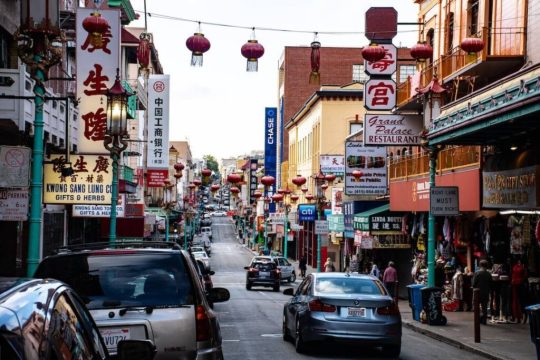
Tourist attractions in China
Tourist attractions in China vary depending on what kind of tourist you are. If you are interested in ancient history, then the Great Wall of China and the Terra Cotta Warriors are a must-see. For those who want to experience Chinese culture, then a trip to Beijing to see the Forbidden City and Tiananmen Square is in order. And no trip to China would be complete without a visit to the Terracotta Warriors in Xi'an. Here are some of the best places to visit in China.
Beijing
Beijing is a popular tourist destination for many reasons. The city is rich in history and culture, and there are many things to see and do. Beijing is also convenient because it is easy to get around and there are many transportation options.
Whether you are interested in exploring the ancient sights or experiencing the city’s modern side, Beijing is the best place for you. Visitors can tour the Forbidden City, walk along the Great Wall of China, or visit Tiananmen Square. For a more modern experience, visitors can check out one of the many shopping malls or restaurants in Beijing. With so much to see and do, it is no wonder that tourism in Beijing is booming. If you are planning a trip to China, be sure to add Beijing to your itinerary.
The best city to visit in France
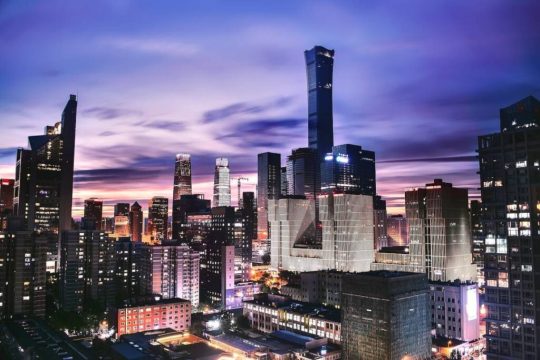
Dongcheng Qu, Beijing Shi, China
Shanghai
Shanghai is a top destination for tourists from all over the world. The city is home to a unique blend of East and West, old and new, which makes it an irresistible destination for travelers. Despite its large size, Shanghai is easy to navigate and there is plenty to see and do. From exploring the French Concession to taking in the view from the top of the Bund, visitors will find plenty to keep them busy in this cosmopolitan city.
Whether you're interested in history, or culture, or just want to enjoy delicious Chinese food, Shanghai has something for everyone. So why not add it to your travel list? You won't be disappointed.

Oriental Pearl Tower, Shanghai
Xian
Xian was once the capital of ancient China and is now a bustling city with a rich history. The city is home to the Terracotta Warriors and the Great Mosque of Xian, both are must-sees for any visitor. Xian is also known for its delicious cuisine, so be sure to try some of the local dishes while you're there. In addition to its historical attractions, Xian also offers a variety of modern amenities that appeal to tourists from all over the world. These include upscale hotels, shopping malls, and restaurants.
Tourism in China is a rapidly growing industry with great potential. With the right policies and infrastructure, China becomes a world-class tourist destination.

Exterior of the Daming Palace in Xian China
Read the full article
0 notes